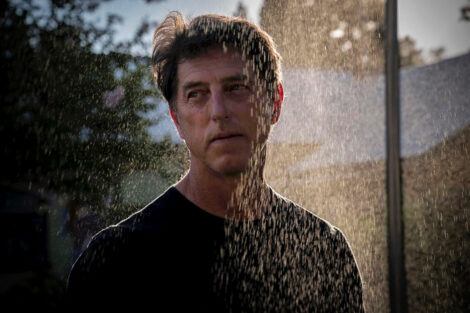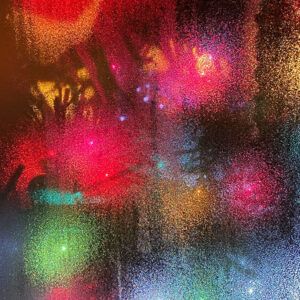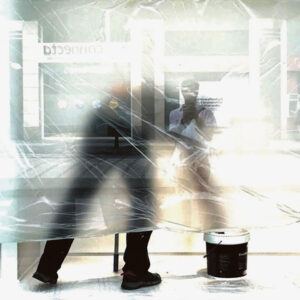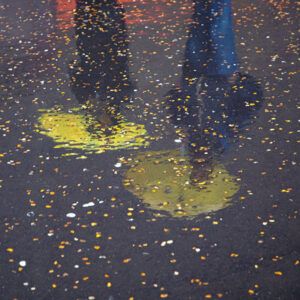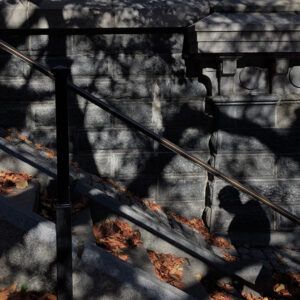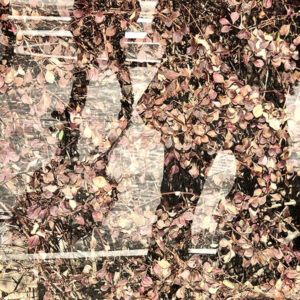Bob Farese Jr.’s new book of photographs captures the things ‘right in front of us but we miss as we blow right by them’
November 17, 2021 – In one of the photographs by Bob Farese Jr., you see geometric pink shapes—which, on closer inspection, are the back and seat of a pink mesh chair and pink-tinted flagstones.
Another photo shows a yellow rectangle and lines of black, red, and white—it looks like a painting by the Dutch artist Piet Mondrian—but it’s actually a roadway with painted lines and a curbside rubber rectangle of raised bumps for people with visual impairments.
At Harvard T.H. Chan School of Public Health, Farese, professor of molecular metabolism and chair of the Department of Molecular Metabolism, is known for his research on how alterations in lipid synthesis and storage contribute to the development of human metabolic diseases, particularly type 2 diabetes. Farese and his scientific partner, Tobias Walther, came to Harvard Chan School in 2014, establishing a lab aimed at making transformative discoveries in lipid metabolism.
But Farese is also an accomplished amateur photographer. Now his images, which highlight the interplay of water, sky, light, shadows, and people—often seen from far off, or partially obscured—are collected in a new book, Am I Not Light, which includes 100 photos and an original poem. The book is accompanied by a short video showing some of the photographs, with music in the background and Farese speaking the words of his poem.
Farese says his interest in science and in photography have plenty in common.
“Sometimes in science you are uncovering things that are right there in front of you but you don’t see at first because you’re focused on a particular result,” he said. “For example, one of the things that my lab is noted for is discovering, about 20 years ago, an enzyme that makes triglycerides, or fats. It was literally a little band on part of a gel that nobody was looking at.” He sees his photos in the same way. “I’m really interested in things right in front of us but we miss as we blow right by them,” he said.
Alone with a phone
Farese started taking a lot of photos shortly after arriving in Boston in 2014. He’d come from the San Francisco Bay Area, where he’d been a senior scientist and professor of medicine, biochemistry and biophysics at the Gladstone Institutes, and was feeling somewhat isolated and alone in his new city. Around the same time, his wife, Nancy Richards Farese, also a photographer, showed him the Instagram feed of David Guttenfelder, a photographer who shoots for National Geographic. Guttenfelder’s photos have an artistic quality, and many are taken with an iPhone.
“I thought, I have my iPhone with me all the time, I can do those sorts of photos, too,” said Farese. “I started noticing things, seeing light and color.”
He wound up taking a class with Guttenfelder, from whom he learned about another photographer, Gueorgui Pinkhassov, who shoots for Magnum Photos, which represents some of the world’s most renowned photographers. Pinkhassov became Farese’s primary mentor. “I studied with him intensively for days at a time,” Farese recalled. “Gueorgui, he’s amazing. He used to say that journalism is like taking a banal image of an amazing moment, while, at the other end, art is like taking amazing images of banal moments. That’s what I like—ordinary moments, but the images are really interesting.”
The book came to fruition because another mentor of Farese’s, photographer Laura El-Tantawy, said the photos in his Instagram feed seemed to have a theme that spoke to feeling alone in a city even while surrounded by other people. “She suggested I put those images together and make a book, and she asked me to write something about that experience, so I wrote a poem,” he said. “The book evolved into a reflection on the human condition, of feeling alone. This all started well before the pandemic, but I think that feeling alone is a condition that more people experienced during the pandemic.”
Farese still takes photos all the time—mostly with his iPhone, but sometimes with more sophisticated cameras. “Taking photos is now part of my life,” he said. “It makes me mindful of the beauty of life.”
Feature photo: Nancy Richards Farese
Photos courtesy Bob Farese Jr.
